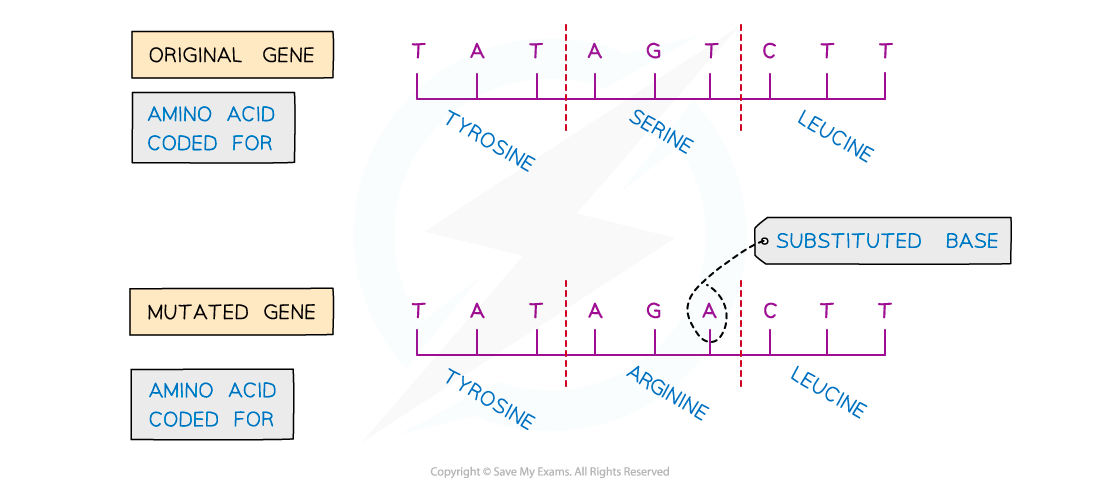- 翰林提供学术活动、国际课程、科研项目一站式留学背景提升服务!
- 400 888 0080
AQA A Level Biology复习笔记4.3.1 Genetic Mutations
Genetic Mutations
- A gene mutation is a change in the sequence of base pairs in a DNA molecule that may result in an altered polypeptide
- Mutations occur continuously
- As the DNA base sequence determines the sequence of amino acids that make up a protein, mutations in a gene can sometimes lead to a change in the polypeptide that the gene codes for
- Most mutations do not alter the polypeptide or only alter it slightly so that its structure or function is not changed
- This is because the genetic code is degenerate
- There are different ways that a mutation in the DNA base sequence can occur:
Insertion of nucleotides
- A mutation that occurs when a nucleotide (with a new base) is randomly inserted into the DNA sequence is known as an insertion mutation
- An insertion mutation changes the amino acid that would have been coded for by the original base triplet, as it creates a new, different triplet of bases
- Remember – every group of three bases in a DNA sequence codes for an amino acid
- An insertion mutation also has a knock-on effect by changing the triplets (groups of three bases) further on in the DNA sequence
- This is sometimes known as a frameshift mutation
- This may dramatically change the amino acid sequence produced from this gene and therefore the ability of the polypeptide to function

An example of an insertion mutation
Deletion of nucleotides
- A mutation that occurs when a nucleotide (and therefore its base) is randomly deleted from the DNA sequence
- Like an insertion mutation, a deletion mutation changes the amino acid that would have been coded for
- Like an insertion mutation, a deletion mutation also has a knock-on effect by changing the groups of three bases further on in the DNA sequence
- This is sometimes known as a frameshift mutation
- This may dramatically change the amino acid sequence produced from this gene and therefore the ability of the polypeptide to function
Substitution of nucleotides
- A mutation that occurs when a base in the DNA sequence is randomly swapped for a different base
- Unlike an insertion or deletion mutation, a substitution mutation will only change the amino acid for the triplet (a group of three bases) in which the mutation occurs; it will not have a knock-on effect
- Substitution mutations can take three forms:
- Silent mutations – the mutation does not alter the amino acid sequence of the polypeptide (this is because certain codons may code for the same amino acid as the genetic code is degenerate)
- Missense mutations – the mutation alters a single amino acid in the polypeptide chain (sickle cell anaemia is an example of a disease caused by a single substitution mutation changing a single amino acid in the sequence)
- Nonsense mutations – the mutation creates a premature stop codon (signal for the cell to stop translation of the mRNA molecule into an amino acid sequence), causing the polypeptide chain produced to be incomplete and therefore affecting the final protein structure and function (cystic fibrosis is an example of a disease caused by a nonsense mutation, although this is not always the only cause)

An example of a substitution mutation
The effect of gene mutations on polypeptides
- Most mutations do not alter the polypeptide or only alter it slightly so that its appearance or function is not changed
- However, a small number of mutations code for a significantly altered polypeptide with a different shape
- This may affect the ability of the protein to perform its function. For example:
- If the shape of the active site on an enzyme changes, the substrate may no longer be able to bind to the active site
- A structural protein (like collagen) may lose its strength if its shape changes
Mutagenic agents
- There are natural mechanisms that take place within cells to ensure the accuracy of DNA replication
- These mechanisms involve proofreading and repairing damaged DNA
- When the mutation rate of a cell rises to above a normal (usually low) rate then these mechanisms have become ineffective
- Mutagenic agents are environmental factors that increase the mutation rate of cells
- Examples include:
- High-energy radiation such as UV light
- Ionising radiation such as X rays
- Toxic chemicals such as peroxides
转载自savemyexams

早鸟钜惠!翰林2025暑期班课上线

最新发布
© 2025. All Rights Reserved. 沪ICP备2023009024号-1








